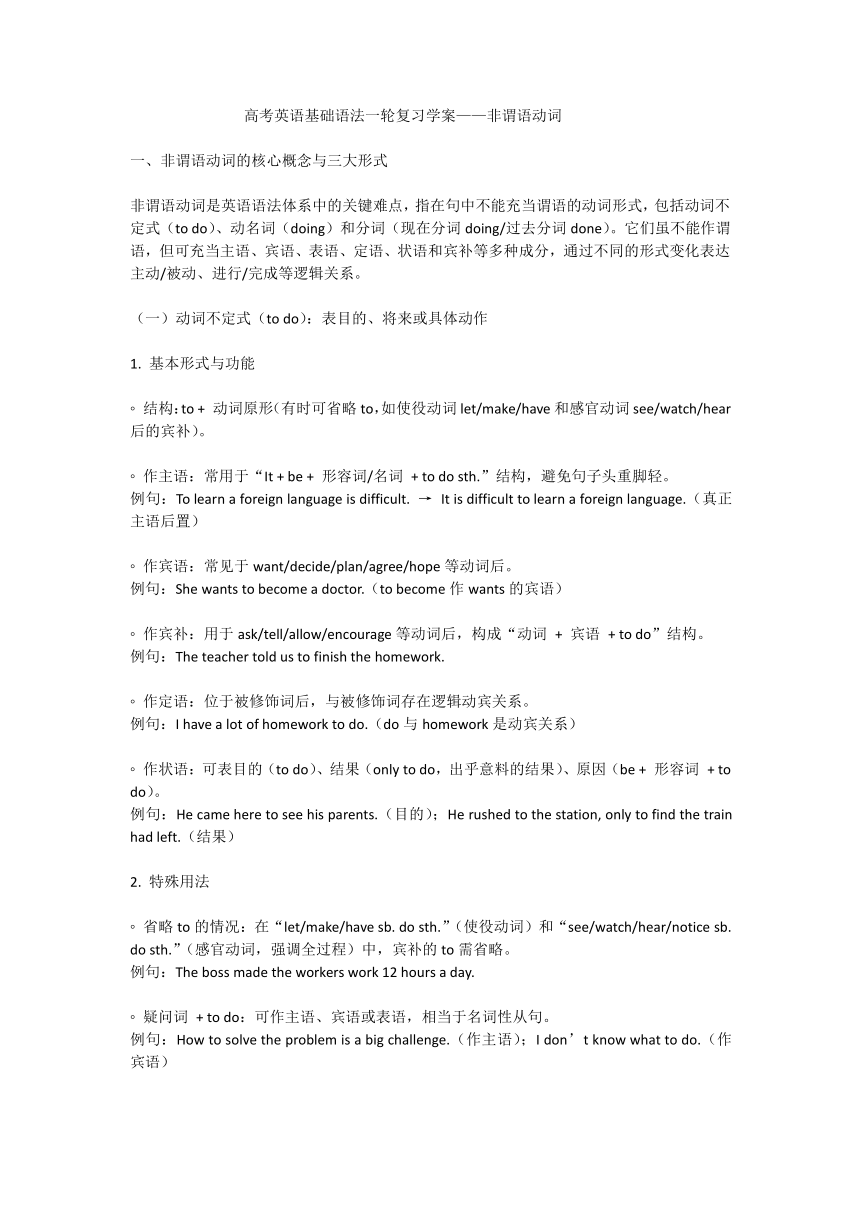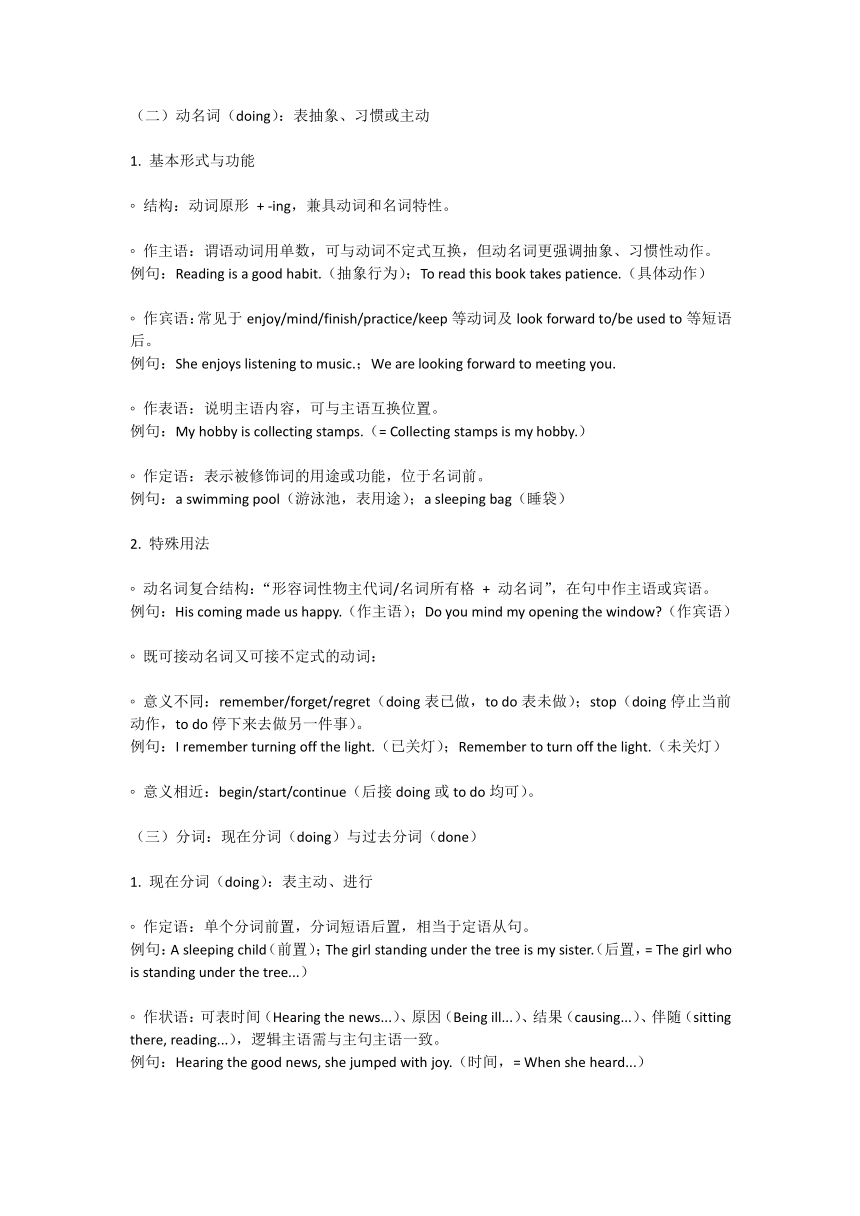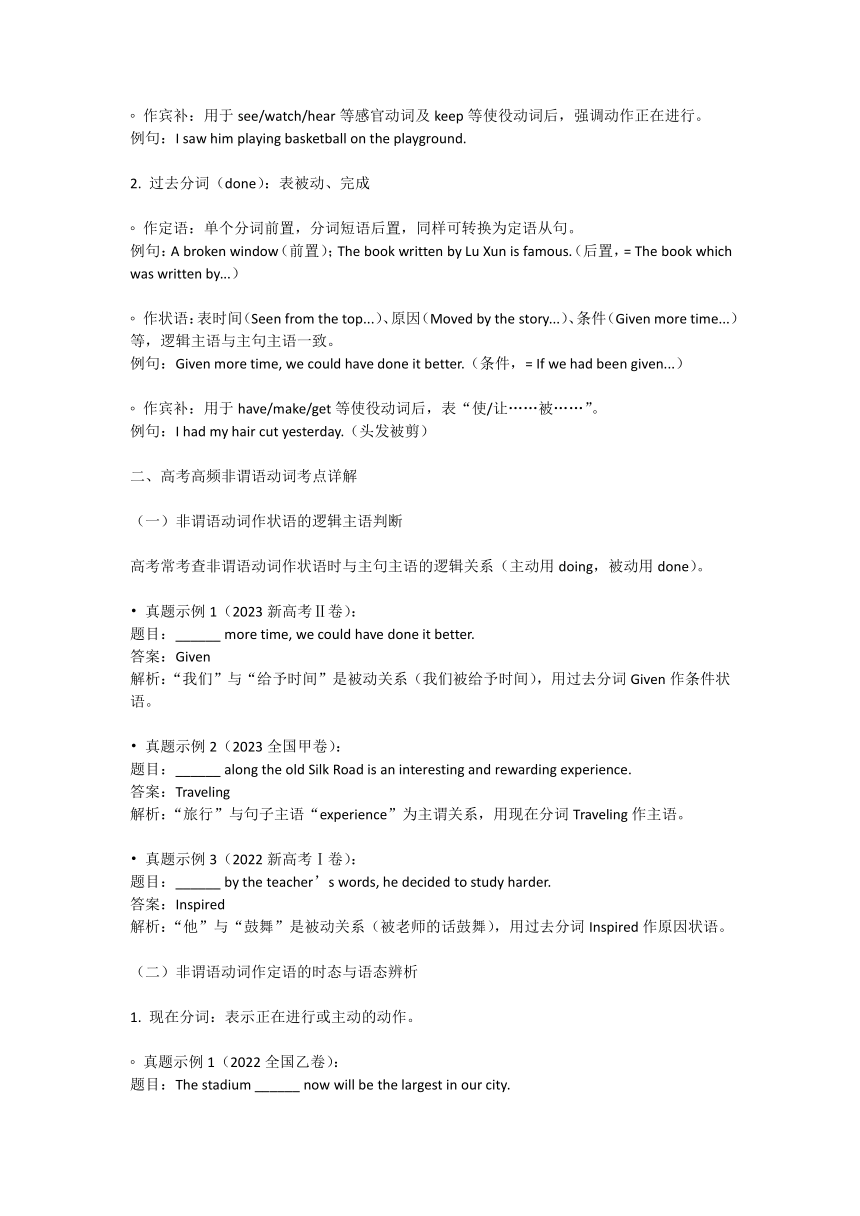高考英语基础语法复习(讲义)—非谓语动词
文档属性
| 名称 | 高考英语基础语法复习(讲义)—非谓语动词 |  | |
| 格式 | docx | ||
| 文件大小 | 16.3KB | ||
| 资源类型 | 教案 | ||
| 版本资源 | 通用版 | ||
| 科目 | 英语 | ||
| 更新时间 | 2025-06-20 18:54:54 | ||
图片预览



文档简介
高考英语基础语法一轮复习学案——非谓语动词
一、非谓语动词的核心概念与三大形式
非谓语动词是英语语法体系中的关键难点,指在句中不能充当谓语的动词形式,包括动词不定式(to do)、动名词(doing)和分词(现在分词doing/过去分词done)。它们虽不能作谓语,但可充当主语、宾语、表语、定语、状语和宾补等多种成分,通过不同的形式变化表达主动/被动、进行/完成等逻辑关系。
(一)动词不定式(to do):表目的、将来或具体动作
1. 基本形式与功能
结构:to + 动词原形(有时可省略to,如使役动词let/make/have和感官动词see/watch/hear后的宾补)。
作主语:常用于“It + be + 形容词/名词 + to do sth.”结构,避免句子头重脚轻。
例句:To learn a foreign language is difficult. → It is difficult to learn a foreign language.(真正主语后置)
作宾语:常见于want/decide/plan/agree/hope等动词后。
例句:She wants to become a doctor.(to become作wants的宾语)
作宾补:用于ask/tell/allow/encourage等动词后,构成“动词 + 宾语 + to do”结构。
例句:The teacher told us to finish the homework.
作定语:位于被修饰词后,与被修饰词存在逻辑动宾关系。
例句:I have a lot of homework to do.(do与homework是动宾关系)
作状语:可表目的(to do)、结果(only to do,出乎意料的结果)、原因(be + 形容词 + to do)。
例句:He came here to see his parents.(目的);He rushed to the station, only to find the train had left.(结果)
2. 特殊用法
省略to的情况:在“let/make/have sb. do sth.”(使役动词)和“see/watch/hear/notice sb. do sth.”(感官动词,强调全过程)中,宾补的to需省略。
例句:The boss made the workers work 12 hours a day.
疑问词 + to do:可作主语、宾语或表语,相当于名词性从句。
例句:How to solve the problem is a big challenge.(作主语);I don’t know what to do.(作宾语)
(二)动名词(doing):表抽象、习惯或主动
1. 基本形式与功能
结构:动词原形 + -ing,兼具动词和名词特性。
作主语:谓语动词用单数,可与动词不定式互换,但动名词更强调抽象、习惯性动作。
例句:Reading is a good habit.(抽象行为);To read this book takes patience.(具体动作)
作宾语:常见于enjoy/mind/finish/practice/keep等动词及look forward to/be used to等短语后。
例句:She enjoys listening to music.;We are looking forward to meeting you.
作表语:说明主语内容,可与主语互换位置。
例句:My hobby is collecting stamps.(= Collecting stamps is my hobby.)
作定语:表示被修饰词的用途或功能,位于名词前。
例句:a swimming pool(游泳池,表用途);a sleeping bag(睡袋)
2. 特殊用法
动名词复合结构:“形容词性物主代词/名词所有格 + 动名词”,在句中作主语或宾语。
例句:His coming made us happy.(作主语);Do you mind my opening the window (作宾语)
既可接动名词又可接不定式的动词:
意义不同:remember/forget/regret(doing表已做,to do表未做);stop(doing停止当前动作,to do停下来去做另一件事)。
例句:I remember turning off the light.(已关灯);Remember to turn off the light.(未关灯)
意义相近:begin/start/continue(后接doing或to do均可)。
(三)分词:现在分词(doing)与过去分词(done)
1. 现在分词(doing):表主动、进行
作定语:单个分词前置,分词短语后置,相当于定语从句。
例句:A sleeping child(前置);The girl standing under the tree is my sister.(后置,= The girl who is standing under the tree...)
作状语:可表时间(Hearing the news...)、原因(Being ill...)、结果(causing...)、伴随(sitting there, reading...),逻辑主语需与主句主语一致。
例句:Hearing the good news, she jumped with joy.(时间,= When she heard...)
作宾补:用于see/watch/hear等感官动词及keep等使役动词后,强调动作正在进行。
例句:I saw him playing basketball on the playground.
2. 过去分词(done):表被动、完成
作定语:单个分词前置,分词短语后置,同样可转换为定语从句。
例句:A broken window(前置);The book written by Lu Xun is famous.(后置,= The book which was written by...)
作状语:表时间(Seen from the top...)、原因(Moved by the story...)、条件(Given more time...)等,逻辑主语与主句主语一致。
例句:Given more time, we could have done it better.(条件,= If we had been given...)
作宾补:用于have/make/get等使役动词后,表“使/让……被……”。
例句:I had my hair cut yesterday.(头发被剪)
二、高考高频非谓语动词考点详解
(一)非谓语动词作状语的逻辑主语判断
高考常考查非谓语动词作状语时与主句主语的逻辑关系(主动用doing,被动用done)。
真题示例1(2023新高考Ⅱ卷):
题目:______ more time, we could have done it better.
答案:Given
解析:“我们”与“给予时间”是被动关系(我们被给予时间),用过去分词Given作条件状语。
真题示例2(2023全国甲卷):
题目:______ along the old Silk Road is an interesting and rewarding experience.
答案:Traveling
解析:“旅行”与句子主语“experience”为主谓关系,用现在分词Traveling作主语。
真题示例3(2022新高考Ⅰ卷):
题目:______ by the teacher’s words, he decided to study harder.
答案:Inspired
解析:“他”与“鼓舞”是被动关系(被老师的话鼓舞),用过去分词Inspired作原因状语。
(二)非谓语动词作定语的时态与语态辨析
1. 现在分词:表示正在进行或主动的动作。
真题示例1(2022全国乙卷):
题目:The stadium ______ now will be the largest in our city.
答案:being built
解析:“体育场”与“建造”是被动关系,且“now”表正在进行,用现在分词的被动式being built作定语。
2. 过去分词:表示完成或被动的动作。
真题示例2(2021全国甲卷):
题目:The novel ______ by Mo Yan is very popular.
答案:written
解析:“小说”与“写”是被动关系,用过去分词written作定语,相当于the novel which was written by Mo Yan。
3. 不定式:表示尚未发生的动作。
真题示例3(2021新高考Ⅰ卷):
题目:The project ______ next year will help improve the local environment.
答案:to be carried out
解析:“项目”与“实施”是被动关系,且“next year”表将来,用不定式的被动式to be carried out作定语。
(三)固定搭配与易错结构
1. 只能接动名词的动词/短语:admit, avoid, consider(考虑), suggest(建议), can’t help(忍不住), be worth等。
真题示例1(2020全国Ⅲ卷):
题目:I suggest ______ (finish) the task ahead of time.
答案:finishing
解析:suggest后接动名词作宾语,故填finishing。
2. 接to do与doing意义不同的动词:try(to do努力;doing尝试)、mean(to do打算;doing意味着)。
真题示例2(2019全国Ⅱ卷):
题目:We must try ______ (solve) the problem as soon as possible.
答案:to solve
解析:此处表示“努力解决问题”,用try to do结构。
3. 独立主格结构:非谓语动词有独立的逻辑主语,与主句主语不一致。
真题示例3(2018全国Ⅰ卷):
题目:______, the party was a great success.
答案:Weather permitting
解析:“天气”是“允许”的逻辑主语,用独立主格结构Weather permitting,相当于If weather permits。
三、高考真题中的非谓语动词考点剖析
1. (2023全国乙卷)
题目:______ around the city, we were impressed by its new look.
答案:Shown
解析:“我们”与“带领参观”是被动关系(我们被带领),用过去分词Shown作时间状语。
2. (2022新高考Ⅱ卷)
题目:The film ______ next month aims mainly at children.
答案:to be released
解析:“电影”与“发行”是被动关系,且“next month”表将来,用不定式的被动式to be released作定语。
3. (2021全国乙卷)
题目:I remembered ______ the door before I left the office, but forgot to turn off the lights.
答案:locking
解析:“记得已做某事”用remember doing,这里表示“记得锁了门”,用locking。
4. (2020全国Ⅰ卷)
题目:______ into English, the sentence was found to have an entirely different word order.
答案:Translated
解析:“句子”与“翻译”是被动关系,用过去分词Translated作时间状语。
5. (2019全国Ⅲ卷)
题目:I appreciate ______ (give) the opportunity to study abroad two years ago.
答案:being given
解析:appreciate后接动名词,“我”与“给机会”是被动关系,用动名词的被动式being given。
四、非谓语动词易错点总结与复习建议
(一)易错点梳理
1. 逻辑主语错误:忽略非谓语动词与主句主语的主动/被动关系,如误用“Seeing from the hill, the city looks beautiful.”(应改为Seen)。
2. 固定搭配混淆:未掌握只能接动名词的动词(如suggest doing)或特殊结构(如look forward to doing)。
3. 时态判断失误:分不清to do(将来)、doing(进行)、done(完成)的时间差异。
4. 独立主格结构误用:混淆独立主格与普通非谓语结构,未识别独立的逻辑主语。
(二)高效复习策略
1. 对比分析法:制作思维导图对比三种非谓语动词的形式、功能和用法,强化记忆。
2. 真题拆解法:分析近五年高考真题,总结高频考点(如状语和定语的非谓语形式)。
3. 语境造句法:针对易错结构(如forget to do/doing),通过造句加深理解。
4. 口诀辅助:如“主动进行用doing,被动完成用done,目的将来用to do”,快速回顾核心规则。
5. 错题归类:整理真题和模拟题中的错题,按“逻辑主语错误”“固定搭配错误”等分类突破。
通过系统梳理非谓语动词的语法规则,结合大量高考真题针对性训练,可有效突破这一高考重难点,提升句子分析与写作能力。
一、非谓语动词的核心概念与三大形式
非谓语动词是英语语法体系中的关键难点,指在句中不能充当谓语的动词形式,包括动词不定式(to do)、动名词(doing)和分词(现在分词doing/过去分词done)。它们虽不能作谓语,但可充当主语、宾语、表语、定语、状语和宾补等多种成分,通过不同的形式变化表达主动/被动、进行/完成等逻辑关系。
(一)动词不定式(to do):表目的、将来或具体动作
1. 基本形式与功能
结构:to + 动词原形(有时可省略to,如使役动词let/make/have和感官动词see/watch/hear后的宾补)。
作主语:常用于“It + be + 形容词/名词 + to do sth.”结构,避免句子头重脚轻。
例句:To learn a foreign language is difficult. → It is difficult to learn a foreign language.(真正主语后置)
作宾语:常见于want/decide/plan/agree/hope等动词后。
例句:She wants to become a doctor.(to become作wants的宾语)
作宾补:用于ask/tell/allow/encourage等动词后,构成“动词 + 宾语 + to do”结构。
例句:The teacher told us to finish the homework.
作定语:位于被修饰词后,与被修饰词存在逻辑动宾关系。
例句:I have a lot of homework to do.(do与homework是动宾关系)
作状语:可表目的(to do)、结果(only to do,出乎意料的结果)、原因(be + 形容词 + to do)。
例句:He came here to see his parents.(目的);He rushed to the station, only to find the train had left.(结果)
2. 特殊用法
省略to的情况:在“let/make/have sb. do sth.”(使役动词)和“see/watch/hear/notice sb. do sth.”(感官动词,强调全过程)中,宾补的to需省略。
例句:The boss made the workers work 12 hours a day.
疑问词 + to do:可作主语、宾语或表语,相当于名词性从句。
例句:How to solve the problem is a big challenge.(作主语);I don’t know what to do.(作宾语)
(二)动名词(doing):表抽象、习惯或主动
1. 基本形式与功能
结构:动词原形 + -ing,兼具动词和名词特性。
作主语:谓语动词用单数,可与动词不定式互换,但动名词更强调抽象、习惯性动作。
例句:Reading is a good habit.(抽象行为);To read this book takes patience.(具体动作)
作宾语:常见于enjoy/mind/finish/practice/keep等动词及look forward to/be used to等短语后。
例句:She enjoys listening to music.;We are looking forward to meeting you.
作表语:说明主语内容,可与主语互换位置。
例句:My hobby is collecting stamps.(= Collecting stamps is my hobby.)
作定语:表示被修饰词的用途或功能,位于名词前。
例句:a swimming pool(游泳池,表用途);a sleeping bag(睡袋)
2. 特殊用法
动名词复合结构:“形容词性物主代词/名词所有格 + 动名词”,在句中作主语或宾语。
例句:His coming made us happy.(作主语);Do you mind my opening the window (作宾语)
既可接动名词又可接不定式的动词:
意义不同:remember/forget/regret(doing表已做,to do表未做);stop(doing停止当前动作,to do停下来去做另一件事)。
例句:I remember turning off the light.(已关灯);Remember to turn off the light.(未关灯)
意义相近:begin/start/continue(后接doing或to do均可)。
(三)分词:现在分词(doing)与过去分词(done)
1. 现在分词(doing):表主动、进行
作定语:单个分词前置,分词短语后置,相当于定语从句。
例句:A sleeping child(前置);The girl standing under the tree is my sister.(后置,= The girl who is standing under the tree...)
作状语:可表时间(Hearing the news...)、原因(Being ill...)、结果(causing...)、伴随(sitting there, reading...),逻辑主语需与主句主语一致。
例句:Hearing the good news, she jumped with joy.(时间,= When she heard...)
作宾补:用于see/watch/hear等感官动词及keep等使役动词后,强调动作正在进行。
例句:I saw him playing basketball on the playground.
2. 过去分词(done):表被动、完成
作定语:单个分词前置,分词短语后置,同样可转换为定语从句。
例句:A broken window(前置);The book written by Lu Xun is famous.(后置,= The book which was written by...)
作状语:表时间(Seen from the top...)、原因(Moved by the story...)、条件(Given more time...)等,逻辑主语与主句主语一致。
例句:Given more time, we could have done it better.(条件,= If we had been given...)
作宾补:用于have/make/get等使役动词后,表“使/让……被……”。
例句:I had my hair cut yesterday.(头发被剪)
二、高考高频非谓语动词考点详解
(一)非谓语动词作状语的逻辑主语判断
高考常考查非谓语动词作状语时与主句主语的逻辑关系(主动用doing,被动用done)。
真题示例1(2023新高考Ⅱ卷):
题目:______ more time, we could have done it better.
答案:Given
解析:“我们”与“给予时间”是被动关系(我们被给予时间),用过去分词Given作条件状语。
真题示例2(2023全国甲卷):
题目:______ along the old Silk Road is an interesting and rewarding experience.
答案:Traveling
解析:“旅行”与句子主语“experience”为主谓关系,用现在分词Traveling作主语。
真题示例3(2022新高考Ⅰ卷):
题目:______ by the teacher’s words, he decided to study harder.
答案:Inspired
解析:“他”与“鼓舞”是被动关系(被老师的话鼓舞),用过去分词Inspired作原因状语。
(二)非谓语动词作定语的时态与语态辨析
1. 现在分词:表示正在进行或主动的动作。
真题示例1(2022全国乙卷):
题目:The stadium ______ now will be the largest in our city.
答案:being built
解析:“体育场”与“建造”是被动关系,且“now”表正在进行,用现在分词的被动式being built作定语。
2. 过去分词:表示完成或被动的动作。
真题示例2(2021全国甲卷):
题目:The novel ______ by Mo Yan is very popular.
答案:written
解析:“小说”与“写”是被动关系,用过去分词written作定语,相当于the novel which was written by Mo Yan。
3. 不定式:表示尚未发生的动作。
真题示例3(2021新高考Ⅰ卷):
题目:The project ______ next year will help improve the local environment.
答案:to be carried out
解析:“项目”与“实施”是被动关系,且“next year”表将来,用不定式的被动式to be carried out作定语。
(三)固定搭配与易错结构
1. 只能接动名词的动词/短语:admit, avoid, consider(考虑), suggest(建议), can’t help(忍不住), be worth等。
真题示例1(2020全国Ⅲ卷):
题目:I suggest ______ (finish) the task ahead of time.
答案:finishing
解析:suggest后接动名词作宾语,故填finishing。
2. 接to do与doing意义不同的动词:try(to do努力;doing尝试)、mean(to do打算;doing意味着)。
真题示例2(2019全国Ⅱ卷):
题目:We must try ______ (solve) the problem as soon as possible.
答案:to solve
解析:此处表示“努力解决问题”,用try to do结构。
3. 独立主格结构:非谓语动词有独立的逻辑主语,与主句主语不一致。
真题示例3(2018全国Ⅰ卷):
题目:______, the party was a great success.
答案:Weather permitting
解析:“天气”是“允许”的逻辑主语,用独立主格结构Weather permitting,相当于If weather permits。
三、高考真题中的非谓语动词考点剖析
1. (2023全国乙卷)
题目:______ around the city, we were impressed by its new look.
答案:Shown
解析:“我们”与“带领参观”是被动关系(我们被带领),用过去分词Shown作时间状语。
2. (2022新高考Ⅱ卷)
题目:The film ______ next month aims mainly at children.
答案:to be released
解析:“电影”与“发行”是被动关系,且“next month”表将来,用不定式的被动式to be released作定语。
3. (2021全国乙卷)
题目:I remembered ______ the door before I left the office, but forgot to turn off the lights.
答案:locking
解析:“记得已做某事”用remember doing,这里表示“记得锁了门”,用locking。
4. (2020全国Ⅰ卷)
题目:______ into English, the sentence was found to have an entirely different word order.
答案:Translated
解析:“句子”与“翻译”是被动关系,用过去分词Translated作时间状语。
5. (2019全国Ⅲ卷)
题目:I appreciate ______ (give) the opportunity to study abroad two years ago.
答案:being given
解析:appreciate后接动名词,“我”与“给机会”是被动关系,用动名词的被动式being given。
四、非谓语动词易错点总结与复习建议
(一)易错点梳理
1. 逻辑主语错误:忽略非谓语动词与主句主语的主动/被动关系,如误用“Seeing from the hill, the city looks beautiful.”(应改为Seen)。
2. 固定搭配混淆:未掌握只能接动名词的动词(如suggest doing)或特殊结构(如look forward to doing)。
3. 时态判断失误:分不清to do(将来)、doing(进行)、done(完成)的时间差异。
4. 独立主格结构误用:混淆独立主格与普通非谓语结构,未识别独立的逻辑主语。
(二)高效复习策略
1. 对比分析法:制作思维导图对比三种非谓语动词的形式、功能和用法,强化记忆。
2. 真题拆解法:分析近五年高考真题,总结高频考点(如状语和定语的非谓语形式)。
3. 语境造句法:针对易错结构(如forget to do/doing),通过造句加深理解。
4. 口诀辅助:如“主动进行用doing,被动完成用done,目的将来用to do”,快速回顾核心规则。
5. 错题归类:整理真题和模拟题中的错题,按“逻辑主语错误”“固定搭配错误”等分类突破。
通过系统梳理非谓语动词的语法规则,结合大量高考真题针对性训练,可有效突破这一高考重难点,提升句子分析与写作能力。
